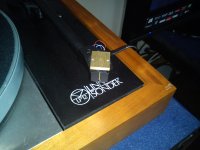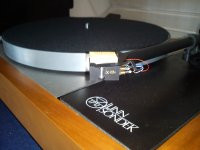Thanks for explanation RCruz.
Isokinetik only can be used if your tonearm can adjust VTA.
Isokinetik only can be used if your tonearm can adjust VTA.
Last edited:
Puresound P10 phono RIAA, schematic & pic (N.B. still don't soldered the 4 ouput caps FT-3 0.47uF)
P.S. Nick if you want I open other thread.
Is that your friend´s tube riaa you were refering to ?
We should not discuss this here but I already studied such schematic in the past.
Mounted & adjusted ready to play
I believe you should have glued the isokinetik stabilizer to the cart and than screw it to the tonearm. ISOKINETIK
Is that your friend´s tube riaa you were refering to ?
We should not discuss this here but I already studied such schematic in the past.
Could you answer me by p.m. or e-mail? thanks Ricardo.
Last edited:
About isokinetik the way I fixed no need to adjust VTA😉
Now the sound with isokinetik has changed a lot to better🙂: less electric & more organic/human that's togheter your big RIAA upgrade😉 the TT become a giants killer or like audiophiles said "high-end" so I need more time to be sure about fine tune RIAA
Now the sound with isokinetik has changed a lot to better🙂: less electric & more organic/human that's togheter your big RIAA upgrade😉 the TT become a giants killer or like audiophiles said "high-end" so I need more time to be sure about fine tune RIAA
You two are doing some ''esoteric'' stuff for a while now, I am not sure what exactly, but I like it you are having fun.😀 Greetings.
All our fun is thanks to your Simplistic NJFET RIAA😀, I recommend you to increase your effective tonearm mass with isokinetik 8gr brass (If I remember well your tonearm is like my Linn Ekos with mid effective mass) or 3gr don't need to be glued or to adjust VTA tonearm if you do like my pic & you will arrive to Olympos😀
Last edited:
I have a Mission 774 actually (John Bicht of Versa Dynamics fame sold that design to Mission back then, could be made by Jelco, many British arms of that era were OEMed in Japan). Problem is if I will increase the mass that far away from the pivot point, the counterweight will not suffice. Its already unwound a lot. If it takes some lathe work for reinforcing it with a brass bit, then a front end flat thingy will be easy to diy also. What is your total mass now including cart?
You two are doing some ''esoteric'' stuff for a while now, I am not sure what exactly, but I like it you are having fun.😀 Greetings.
Hi Salas
Based on your input, I updated my simplistic simulator that seems to be able to pinpoint the 500.5 pole.
It does not work very well for the higher frequencies so I am basing myself on your latest pdf. (According to my calc there seems to be a "missing 800~850pF" that I am taking for granted and calling it "special miller of the second stage".)
I would like to test this simulator on merlin´s tube schematic but I am not sure how to determine the first stage output impedance.
If Merlin decides to open a new thread I hope you join to help.
I have a Mission 774 actually (John Bicht of Versa Dynamics fame sold that design to Mission back then, could be made by Jelco, many British arms of that era were OEMed in Japan). Problem is if I will increase the mass that far away from the pivot point, the counterweight will not suffice. Its already unwound a lot. If it takes some lathe work for reinforcing it with a brass bit, then a front end flat thingy will be easy to diy also. What is your total mass now including cart?
Fortunately my Ekos counterweight is suffice, another idea it's work without counterweight😉
Tonearm 11.5gr
Cart 8.5gr
Isokinetick brass 8gr
Screws & fasteners 0.5gr
Total 28.5gr
The Denon DL103R compliance rating: 5x10-6 cm/dyne (at 100 hz) at 10 - 11 hz has been calculated to be approximately 11x10-6cm/dyne so now I have a tonearm resonant frecuency of aprox. 9Hz🙂
Isokinetick do another to added only 3gr
Did you determine true DL103r compliance using a test record ?
I believe it was proven to be much higher than that.
http://www.diyaudio.com/forums/analogue-source/129126-simplistic-njfet-riaa-386.html#post2210811
I believe it was proven to be much higher than that.
http://www.diyaudio.com/forums/analogue-source/129126-simplistic-njfet-riaa-386.html#post2210811
Last edited:
Hi Salas
Based on your input, I updated my simplistic simulator that seems to be able to pinpoint the 500.5 pole.
It does not work very well for the higher frequencies so I am basing myself on your latest pdf. (According to my calc there seems to be a "missing 800~850pF" that I am taking for granted and calling it "special miller of the second stage".)
I would like to test this simulator on merlin´s tube schematic but I am not sure how to determine the first stage output impedance.
If Merlin decides to open a new thread I hope you join to help.
New thread open, also asked designer/manufacturer the output impedance of first stage
http://www.diyaudio.com/forums/analogue-source/190613-puresound-p10-riaa.html#post2600869
Thanks in advance for kind help
Did you determine true DL103r compliance using a test record ?
I believe it was proven to be much higher than that.
Tested the real cartridge/arm vertical resonance with Hi-Fi New Analogue Test LP result: in the middle between 7-9Hz so I assume 8Hz aprox. (not to far my calculations), doing again calculations I calculated for 8 Hz a real compliance cart of 13.5 (not 11 as The Analog Depot & not 17.5 my previous calculations you linked)
See here: http://www.theanalogdept.com/denon_dl-103r.htm
Last edited:
Helppppp please 😉
after extremely good results with the MC Version i´d like to try another
one just for MM-systems. As this thread is so long....could someone please
link me to one circuit...
As for the 170bl...i´ve got plenty of them between 6,6 and 10, so there will be
lots of close pairs and there are also some gr´s from 3 to 4,9
Greetings Ulf
after extremely good results with the MC Version i´d like to try another
one just for MM-systems. As this thread is so long....could someone please
link me to one circuit...
As for the 170bl...i´ve got plenty of them between 6,6 and 10, so there will be
lots of close pairs and there are also some gr´s from 3 to 4,9
Greetings Ulf
Helppppp please 😉
after extremely good results with the MC Version i´d like to try another
one just for MM-systems. As this thread is so long....could someone please
link me to one circuit...
As for the 170bl...i´ve got plenty of them between 6,6 and 10, so there will be
lots of close pairs and there are also some gr´s from 3 to 4,9
Greetings Ulf
Ulf, Salas PDF here http://www.diyaudio.com/forums/analogue-source/129126-simplistic-njfet-riaa-495.html#post2308275
Cheers, Felipe
Not the original 774 AFAIK. Jelco made the various 774LC, LCII, Cyrus, etc.I have a Mission 774 actually (John Bicht of Versa Dynamics fame sold that design to Mission back then, could be made by Jelco, many British arms of that era were OEMed in Japan).
Do you have the first solid counterweight or the silicon rubber decoupled one?
Did you ever try the fluid damper?
Helppppp please 😉
after extremely good results with the MC Version i´d like to try another
one just for MM-systems. As this thread is so long....could someone please
link me to one circuit...
As for the 170bl...i´ve got plenty of them between 6,6 and 10, so there will be
lots of close pairs and there are also some gr´s from 3 to 4,9
Greetings Ulf
Let us know your NJFET stash so Salas will give you advice about wich will be used & positions
RIAA
It seems lack bass, I have 15.333nF the best chance to have more highs is 15.1nF or other exact value?
If you feel it lacks highs, you can lower C3 to 15.1nF as per Salas pdf.
It seems lack bass, I have 15.333nF the best chance to have more highs is 15.1nF or other exact value?
- Home
- Source & Line
- Analogue Source
- Simplistic NJFET RIAA

